engine HONDA ACCORD COUPE 2000 CF / 6.G Service Manual
[x] Cancel search | Manufacturer: HONDA, Model Year: 2000, Model line: ACCORD COUPE, Model: HONDA ACCORD COUPE 2000 CF / 6.GPages: 338, PDF Size: 4.82 MB
Page 291 of 338
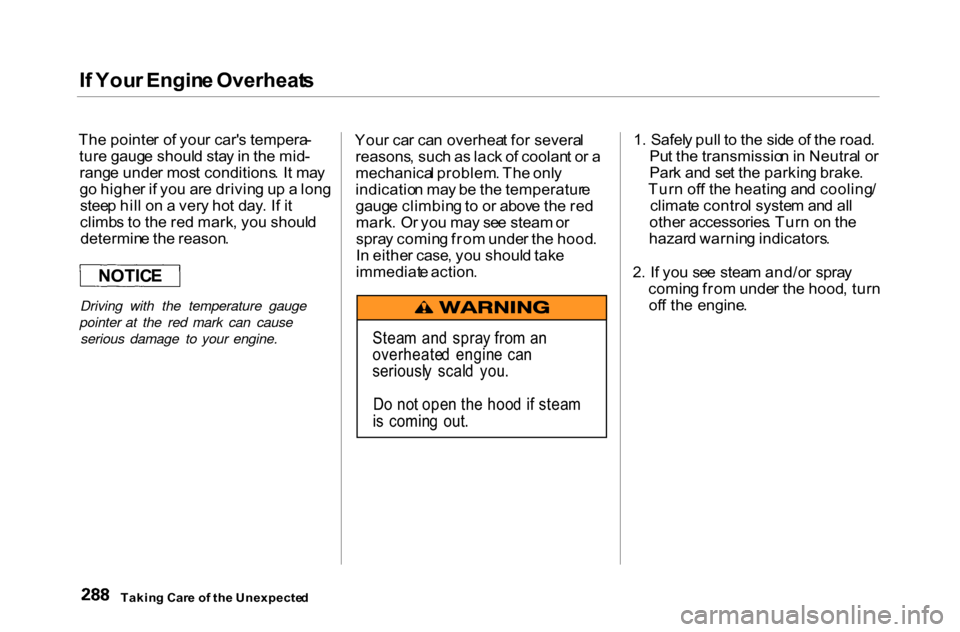
I
f You r Engin e Overheat s
Th e pointe r o f you r car' s tempera -
tur e gaug e shoul d sta y in th e mid -
rang e unde r mos t conditions . I t ma y
g o highe r i f yo u ar e drivin g u p a lon g
stee p hil l o n a ver y ho t day . I f i t
climb s t o th e re d mark , yo u shoul d
determin e th e reason .
Driving with the temperature gauge
pointer at the red mark can cause serious damage to your engine. You
r ca r ca n overhea t fo r severa l
reasons , suc h a s lac k o f coolan t o r a
mechanica l problem . Th e onl y
indicatio n ma y b e th e temperatur e
gaug e climbin g to o r abov e th e re d
mark . O r yo u ma y se e steam or
spra y comin g fro m unde r th e hood .
I n eithe r case , yo u shoul d tak e
immediat e action . 1
. Safel y pul l t o th e sid e o f th e road .
Pu t th e transmissio n in Neutra l o r
Par k an d se t th e parkin g brake .
Tur n of f th e heatin g an d cooling /
climat e contro l syste m an d al l
othe r accessories . Tur n o n th e
hazar d warnin g indicators .
2 . I f yo u se e stea m and/o r spra y
comin g fro m unde r th e hood , tur n
of f th e engine .
Takin g Car e o f th e Unexpecte d
NOTIC
E
Steam an d spra y fro m a n
overheate d engin e ca n
seriousl y scal d you .
D o no t ope n th e hoo d i f stea m
i s comin g out .
Page 292 of 338

I
f You r Engin e Overheat s
3 . I f yo u d o no t se e stea m or spray ,
leav e th e engin e runnin g an d
watc h th e temperatur e gauge . I f
th e hig h hea t i s du e to overloadin g
(climbin g a long , stee p hil l o n a
ho t da y wit h th e A/ C running , fo r
example) , th e engin e shoul d star t
t o coo l dow n almos t immediately .
I f i t does , wai t unti l th e tempera -
tur e gaug e come s dow n to th e mid -
poin t the n continu e driving .
4 . I f th e temperatur e gaug e stay s a t
th e re d mark , tur n of f th e engine .5
. Wai t unti l yo u se e n o mor e sign s
o f stea m or spray , the n ope n th e
hood .
6 . Loo k fo r an y obviou s coolan t leaks ,
suc h a s a spli t radiato r hose .
Everythin g is stil l extremel y hot ,
s o us e caution . I f yo u fin d a leak , i t
mus t b e repaire d befor e yo u
continu e drivin g (se e Emergenc y
Towin g o n pag e 301 ).
7 . I f yo u don' t fin d a n obviou s leak ,
chec k th e coolan t leve l i n th e
radiato r reserv e tan k (se e pag e
166 ). I f th e leve l i s belo w th e
MI N mark , ad d coolan t t o halfwa y
betwee n th e MI N an d MA X marks .8
. I f ther e wa s n o coolan t i n th e
reserv e tank , yo u ma y als o hav e to
ad d coolan t t o th e radiator . Le t th e
engin e coo l dow n unti l th e pointe r
reache s th e middl e o f th e tempera -
tur e gauge , o r lower , befor e check -
in g th e radiator .
CONTINUED
Takin g Car e o f th e Unexpecte d
Removin
g th e radiato r ca p
whil e th e engin e i s ho t ca n
caus e th e coolan t t o spra y out ,
seriousl y scaldin g you .
Alway s le t th e engin e an d
radiato r coo l dow n befor e
removin g th e radiato r cap .
Page 294 of 338

Lo
w Oi l Pressur e Indicato r
LO W OI L PRESSUR E INDICATO R
Thi s indicato r shoul d ligh t whe n th e
ignitio n switc h is O N (II) , an d g o ou t
afte r th e engin e starts . I t shoul d
neve r com e o n whe n th e engin e is
running . I f i t start s flashing , i t
indicate s tha t th e oi l pressur e
droppe d ver y lo w fo r a moment , the n
recovered . I f th e indicato r stay s o n
wit h th e engin e running , i t show s
tha t th e engin e ha s los t oi l pressur e
an d seriou s engin e damag e is
possible . I n eithe r case , yo u shoul d
tak e immediat e action .
Running the engine with low oil
pressure can cause serious mechanical
damage almost immediately. Turn off
the engine as soon as you can safely get
the car stopped.
1 . Safel y pul l of f th e roa d an d shu t
of f th e engine . Tur n o n th e hazar d
warnin g indicators .
2 . Le t th e ca r si t fo r a minute . Ope n
th e hoo d an d chec k th e oi l leve l
(se e pag e 16 4 ) . Althoug h oi l leve l
an d oi l pressur e ar e no t directl y
connected , a n engin e tha t i s ver y
lo w o n oi l ca n los e pressur e durin g
cornerin g an d othe r drivin g
maneuvers .
3 . I f necessary , ad d oi l t o brin g th e
leve l bac k t o th e ful l mar k o n th e
dipstic k (se e pag e 212). 4
. Star t th e engin e an d watc h th e oi l
pressur e indicator . I f th e ligh t
doe s no t g o ou t withi n te n seconds ,
tur n of f th e engine . Ther e is a
mechanica l proble m tha t need s t o
b e repaire d befor e yo u ca n
continu e driving . (Se e Emergenc y
Towin g o n pag e 301 .)
Takin g Car e o f th e Unexpecte d
NOTIC
E
Page 296 of 338
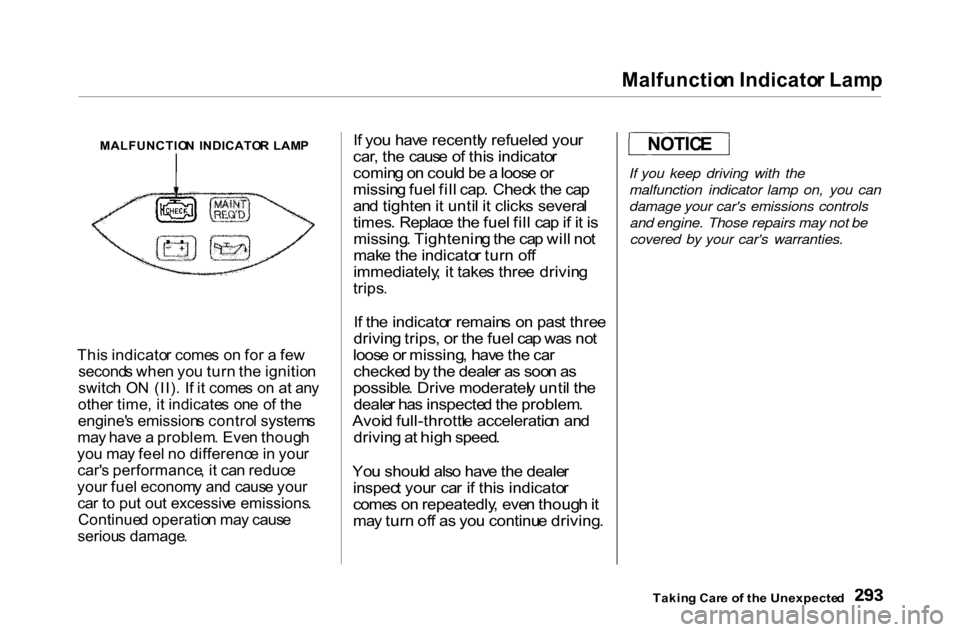
Malfunctio
n Indicato r Lam p
Thi s indicato r come s o n fo r a fe w
second s whe n yo u tur n th e ignitio n
switc h O N (II) . I f i t come s o n a t an y
othe r time , i t indicate s on e o f th e
engine' s emission s contro l system s
ma y hav e a problem . Eve n thoug h
yo u ma y fee l n o differenc e in you r
car' s performance , i t ca n reduc e
you r fue l econom y an d caus e you r
ca r t o pu t ou t excessiv e emissions .
Continue d operatio n ma y caus e
seriou s damage .
I
f yo u hav e recentl y refuele d you r
car , th e caus e o f thi s indicato r
comin g o n coul d b e a loos e o r
missin g fue l fil l cap . Chec k th e ca p
an d tighte n it unti l i t click s severa l
times . Replac e th e fue l fil l ca p if i t i s
missing . Tightenin g th e ca p wil l no t
mak e th e indicato r tur n of f
immediately ; i t take s thre e drivin g
trips .
I f th e indicato r remain s o n pas t thre e
drivin g trips , o r th e fue l ca p wa s no t
loos e o r missing , hav e th e ca r
checke d b y th e deale r a s soo n a s
possible . Driv e moderatel y unti l th e
deale r ha s inspecte d th e problem .
Avoi d full-throttl e acceleratio n an d
drivin g a t hig h speed .
Yo u shoul d als o hav e th e deale r
inspec t you r ca r i f thi s indicato r
come s o n repeatedly , eve n thoug h it
ma y tur n of f a s yo u continu e driving .If you keep driving with the
malfunction indicator lamp on, you can
damage your car's emissions controlsand engine. Those repairs may not becovered by your car's warranties.
Takin g Car e o f th e Unexpecte d
MALFUNCTIO
N INDICATO R LAM P
NOTICE
Page 297 of 338
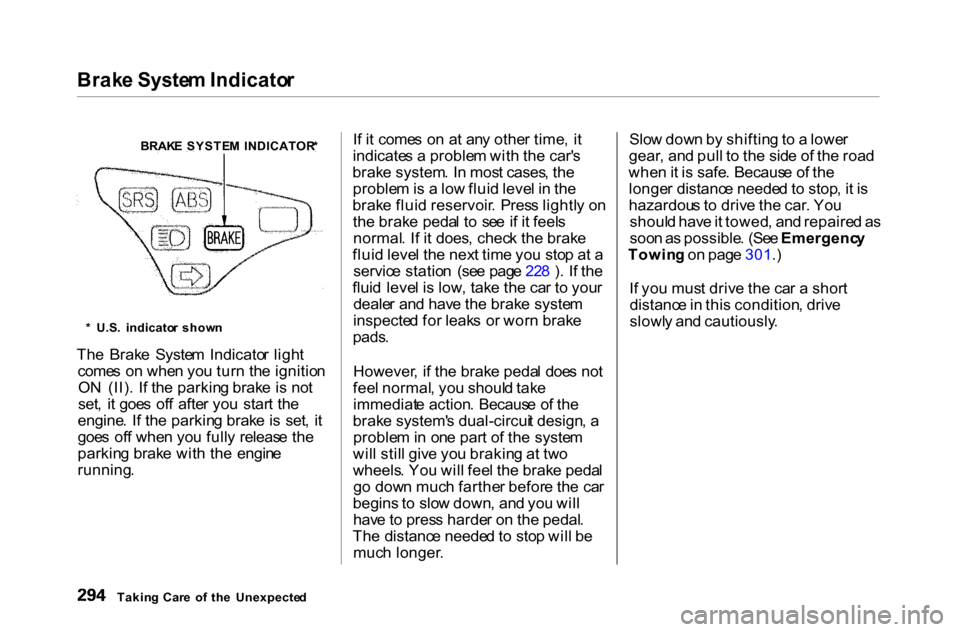
Brak
e Syste m Indicato r
Th e Brak e Syste m Indicato r ligh t
come s o n whe n yo u tur n th e ignitio n
O N (II) . I f th e parkin g brak e i s no t
set , i t goe s of f afte r yo u star t th e
engine . I f th e parkin g brak e is set , i t
goe s of f whe n yo u full y releas e th e
parkin g brak e wit h th e engin e
running . I
f i t come s o n a t an y othe r time , i t
indicate s a proble m wit h th e car' s
brak e system . I n mos t cases , th e
proble m is a lo w flui d leve l i n th e
brak e flui d reservoir . Pres s lightl y o n
th e brak e peda l t o se e i f i t feel s
normal . I f i t does , chec k th e brak e
flui d leve l th e nex t tim e yo u sto p a t a
servic e statio n (se e pag e 22 8 ) . I f th e
flui d leve l i s low , tak e th e ca r t o you r
deale r an d hav e th e brak e syste m
inspecte d fo r leak s o r wor n brak e
pads .
However , i f th e brak e peda l doe s no t
fee l normal , yo u shoul d tak e
immediat e action . Becaus e o f th e
brak e system' s dual-circui t design , a
proble m in on e par t o f th e syste m
wil l stil l giv e yo u brakin g a t tw o
wheels . Yo u wil l fee l th e brak e peda l
g o dow n muc h farthe r befor e th e ca r
begins to slo w down , an d yo u wil l
hav e t o pres s harde r o n th e pedal .
Th e distanc e neede d to sto p wil l b e
muc h longer . Slo
w dow n b y shiftin g to a lowe r
gear , an d pul l t o th e sid e o f th e roa d
whe n it i s safe . Becaus e o f th e
longe r distanc e neede d to stop , i t i s
hazardou s t o driv e th e car . Yo u
shoul d hav e it towed , an d repaire d a s
soo n a s possible . (Se e Emergenc y
Towin g o n pag e 301 .)
I f yo u mus t driv e th e ca r a shor t
distanc e in thi s condition , driv e
slowl y an d cautiously .
Takin g Car e o f th e Unexpecte d
BRAK
E SYSTE M INDICATOR *
* U.S . indicato r show n
Page 304 of 338
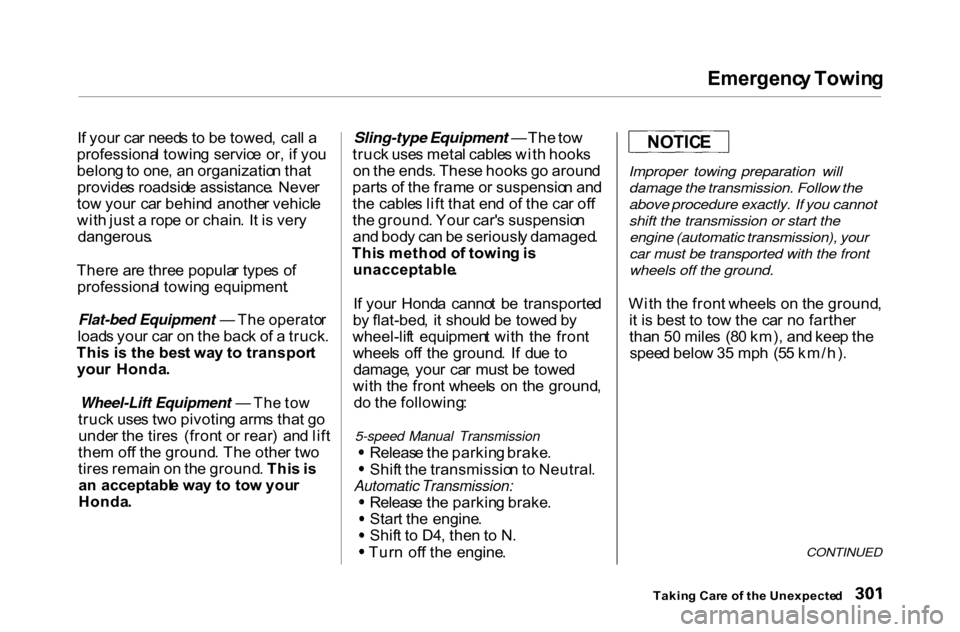
Emergenc
y Towin g
I f you r ca r need s t o b e towed , cal l a
professiona l towin g servic e or , i f yo u
belon g to one , a n organizatio n tha t
provide s roadsid e assistance . Neve r
to w you r ca r behin d anothe r vehicl e
wit h jus t a rop e o r chain . I t i s ver y
dangerous .
Ther e ar e thre e popula r type s o f
professiona l towin g equipment .
Flat-bed Equipment — Th e operato r
load s you r ca r o n th e bac k o f a truck .
Thi s i s th e bes t wa y t o transpor t
you r Honda .
Wheel-Lift Equipment — Th e to w
truc k use s tw o pivotin g arm s tha t g o
unde r th e tire s (fron t o r rear ) an d lif t
the m of f th e ground . Th e othe r tw o
tire s remai n o n th e ground . Thi s is
a n acceptabl e wa y t o to w you r
Honda .
Sling-type Equipment — Th
e to w
truc k use s meta l cable s wit h hook s
o n th e ends . Thes e hook s g o aroun d
part s o f th e fram e o r suspensio n an d
th e cable s lif t tha t en d o f th e ca r of f
th e ground . You r car' s suspensio n
an d bod y ca n b e seriousl y damaged .
Thi s metho d o f towin g is
unacceptable .
I f you r Hond a canno t b e transporte d
b y flat-bed , i t shoul d b e towe d b y
wheel-lif t equipmen t wit h th e fron t
wheel s of f th e ground . I f du e t o
damage , you r ca r mus t b e towe d
wit h th e fron t wheel s o n th e ground ,
d o th e following :
5-speed Manual Transmission Releas e th e parkin g brake .
Shif t th e transmissio n to Neutral .
Automatic Transmission:
Releas e th e parkin g brake .
Star t th e engine .
Shif t t o D4 , the n to N .
Tur n of f th e engine .
Improper towing preparation will
damage the transmission. Follow the
above procedure exactly. If you cannot
shift the transmission or start the
engine (automatic transmission), your
car must be transported with the front
wheels off the ground.
Wit h th e fron t wheel s o n th e ground ,
i t i s bes t t o to w th e ca r n o farthe r
tha n 5 0 mile s (8 0 km) , an d kee p th e
spee d belo w 3 5 mp h (5 5 km/h) .
CONTINUED
Takin g Car e o f th e Unexpecte d
NOTIC
E
Page 308 of 338

Identificatio
n Number s
Th e Engin e Numbe r i s stampe d int o
th e engin e block . I t i s o n th e front .
Th e Transmissio n Numbe r i s o n a
labe l o n to p o f th e transmission .
Technical Informatio n
4
cylinde r Model s
AUTOMATIC TRANSMISSIO N NUMBE R
ENGIN E NUMBE R
6-cylinde r Model s
ENGINE NUMBE R
MANUA
L
TRANSMISSIO N
NUMBE R
AUTOMATI C TRANSMISSIO N NUMBE R
Page 309 of 338

*
1
: Includin g th e coolan t i n th e reserv e tan k an d tha t remainin g i n th e
engine .
Reserv e tan k capacity :
0.1 6 U S ga l (0. 6 , 0.1 3 Im p gal )
* 2
: Excludin g th e oi l remainin g i n th e engine .
Technica l Informatio n
Page 311 of 338
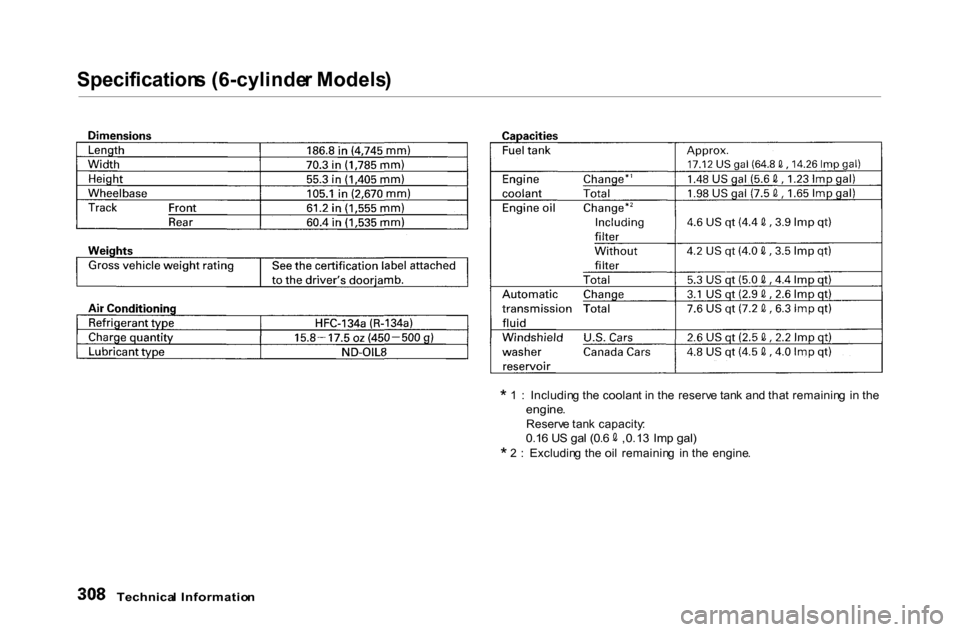
Specification
s (6-cylinde r Models )
* 1
: Includin g th e coolan t i n th e reserv e tan k an d tha t remainin g i n th e
engine .
Reserv e tan k capacity :
0.1
6 U S ga l (0. 6 ,0.1 3 Im p gal )
* 2
: Excludin g th e oi l remainin g i n th e engine .
Technica l Informatio n
Page 317 of 338
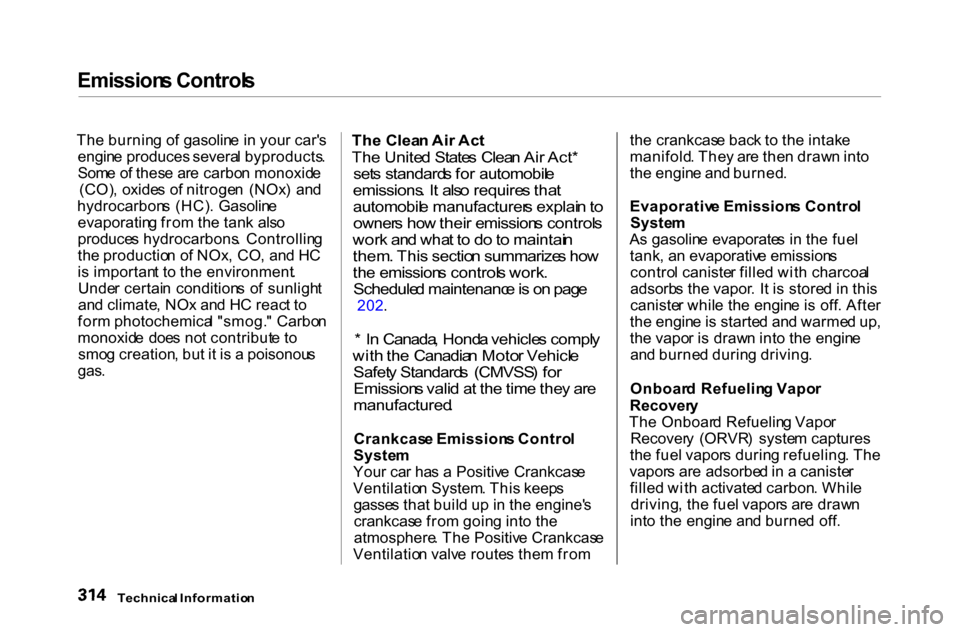
Emission
s Control s
Th e burnin g o f gasolin e i n you r car' s
engin e produces several byproducts .
Som e o f thes e ar e carbo n monoxid e
(CO) , oxide s o f nitroge n (NOx ) an d
hydrocarbon s (HC) . Gasolin e
evaporatin g fro m th e tan k als o
produce s hydrocarbons . Controllin g
th e productio n o f NOx , CO , an d H C
i s importan t t o th e environment .
Unde r certai n condition s o f sunligh t
an d climate , NO x an d H C reac t t o
for m photochemica l "smog. " Carbo n
monoxid e doe s no t contribut e t o
smo g creation , bu t i t i s a poisonou s
gas .
Th
e Clea n Ai r Ac t
Th e Unite d State s Clea n Ai r Act *
set s standard s fo r automobil e
emissions . I t als o require s tha t
automobil e manufacturer s explai n to
owner s ho w thei r emission s control s
wor k an d wha t t o d o to maintai n
them . Thi s sectio n summarize s ho w
th e emission s control s work .
Schedule d maintenanc e is o n pag e
202 .
* I n Canada , Hond a vehicle s compl y
wit h th e Canadia n Moto r Vehicl e
Safet y Standard s (CMVSS ) fo r
Emission s vali d a t th e tim e the y ar e
manufactured .
Crankcas e Emission s Contro l
Syste m
You r ca r ha s a Positiv e Crankcas e
Ventilatio n System . Thi s keep s
gasse s tha t buil d u p in th e engine' s
crankcas e fro m goin g int o th e
atmosphere . Th e Positiv e Crankcas e
Ventilatio n valv e route s the m fro m th
e crankcas e bac k t o th e intak e
manifold . The y ar e the n draw n int o
th e engin e an d burned .
Evaporativ e Emission s Contro l
Syste m
A s gasolin e evaporate s i n th e fue l
tank , a n evaporativ e emission s
contro l caniste r fille d wit h charcoa l
adsorb s th e vapor . I t i s store d in thi s
caniste r whil e th e engin e i s off . Afte r
th e engin e is starte d an d warme d up ,
th e vapo r i s draw n int o th e engin e
an d burne d durin g driving .
Onboar d Refuelin g Vapo r
Recover y
Th e Onboar d Refuelin g Vapo r
Recover y (ORVR ) syste m captures
th e fue l vapor s durin g refueling . Th e
vapor s ar e adsorbe d in a caniste r
fille d wit h activate d carbon . Whil e
driving , th e fue l vapor s ar e draw n
int o th e engin e an d burne d off .
Technica l Informatio n